#1965 ford falcon
Explore tagged Tumblr posts
Text
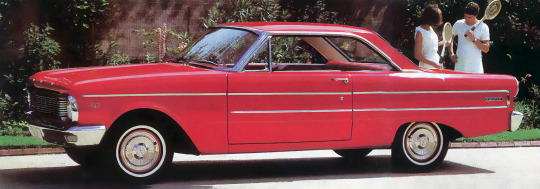
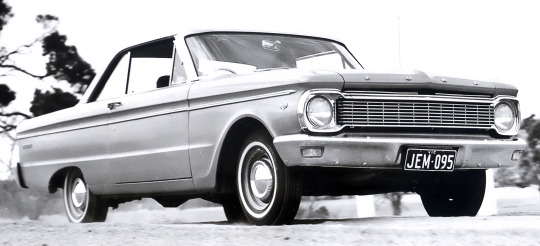
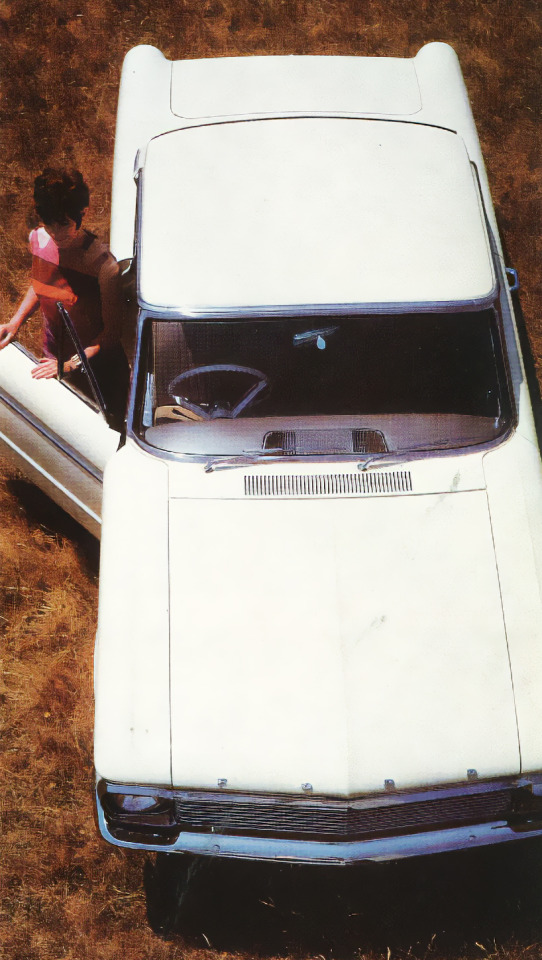


Ford Falcon XP Hardtop, 1965. The XP was a "make or break" model, Ford's future in Australia depended on the car succeeding. It was the 4th iteration of the first generation Australian Falcon and though still related to US models (it shared bonnet and front guards with the 1960-63 Mercury Comet) it had been designed in Australia. To prove the model's durability a fleet of 5 cars were driven non-stop around Ford's You-Yangs testing grounds for 70,000 miles at an average speed of over 70mph. It went on to win the Wheel's Australian Car of Year award. However when it was replaced by the new generation XR in 1966 the Hardtop was not replaced and it wasn't until the XA of 1972 that the Falcon Coupé was resurrected.
#Ford#Falcon#Ford Falcon#Ford Falcon XP Hardtop#Ford Falcon Hardtop#Ford Falcon XP#1965#Ford Australia#pillarless hardtop#straight 6#hardtop coupe#1960s#first generation
127 notes
·
View notes
Text

65 Ford Falcon in Tropical Turquoise
5 notes
·
View notes
Text
My dad's 65 ford falcon
6 notes
·
View notes
Text



1965 Ford Falcon Station Wagon
2 notes
·
View notes
Text

Drive/Way - Falcon 36x24"/91.5x61cm, mixed media on canvas.
Commissioned painting of a custom 1965 Ford Falcon.
1 note
·
View note
Text




Ford Falcon V8 Hardtop Custom 1965. - source Classic and Modern Show Cars AU.
24 notes
·
View notes
Text
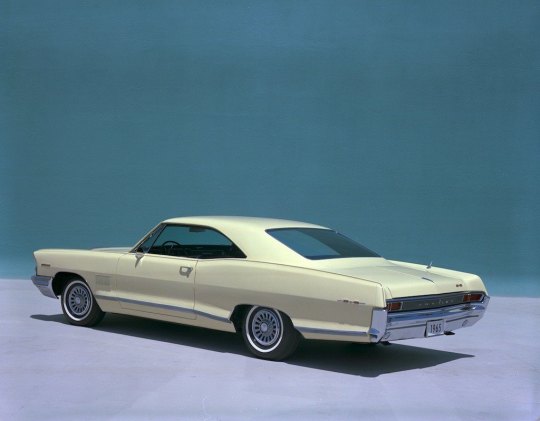
10 Forgotten Muscle Cars That Deserve to Be Restored
by James Derek Sapienza
Source: General Motors We all know the story; it started in 1964 with the Ford Mustang. No, wait — I mean the Plymouth Barracuda. Or the Pontiac GTO. Or was it earlier with the Pontiac Catalina SD? The ’50s Dodge D-500 maybe? Debating the origin of the muscle car is like debating over the first rock and roll record; everyone you talk to has a different opinion, and no one is exactly wrong. Let’s just say that by the early ’60s, a generation coming of age fell in love with high-performance midsize cars coming out of Detroit, and for a few brief years, performance ruled the day. Naturally, the good old days seem to look better with each passing year, and as the book was written on the muscle car, a fair amount of contenders fell by the wayside.

1. 1964 Studebaker Avanti R3
Source: Auctions America The Avanti isn’t generally counted among muscle cars, but then, Studebaker was never exactly considered a performance powerhouse to begin with. But the fiberglass Avanti had a long hood, short rear deck, and 289-cubic-inch V8 a full two years before the Ford Mustang did. In 1964 (after production officially ended), Studebaker bored out nine V8s to 304 cubic inches, slapped a Paxton supercharger on them, and dropped them into remaining Avantis. The result was a 171-mile-per-hour rocket, which the company claimed made it the fastest production car in America. This R3 was sold by Auctions America in 2010 for $96,250. With the collector market being what it is today, good luck finding one this cheap ever again.
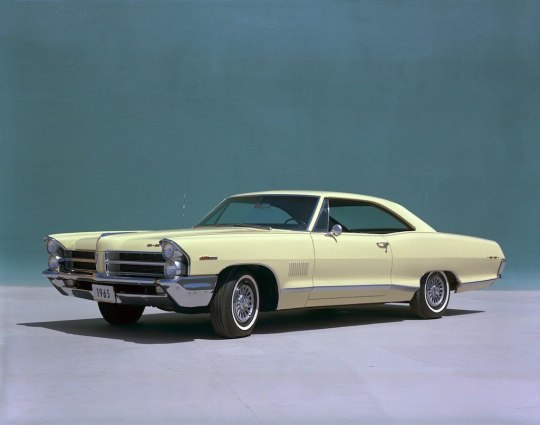
2. 1965 Pontiac 2+2
Source: General Motors As far as classic muscle cars go, the ’65-’67 GTO is remembered to be about as big as they came. But with the success of the GTO, Pontiac wanted to take its go-fast formula to an even bigger car, which became the ’65-’67 2+2. Based on the full-size Catalina two-door, the 2+2 had its own unique 338-horsepower 421-cubic-inch V8, and in High Output guise, power jumped to 376 ponies, which when tuned right could rocket from zero to 60 in a mind-bending 3.9 seconds. Bigger, plusher, and often faster than its smaller stablemate, the 2+2 deserves a lot more love from speed freaks.

3. 1964 Mercury Comet Cyclone
Source: Ford For ’60s Ford products, the Mercury Comet was about as basic as they came. Closely based on the Ford Falcon, the ’64-’65 Comet could be livened up with Ford’s famous 289-cubic-inch V8. But for those who wanted more from their Mercurys, Ford built 50 Comet Cyclones for the dragstrip, complete with fiberglass hood, fenders, doors and front bumper, plexiglass windows, and the same 425-horsepower 427 V8 found in the Shelby Cobra. In ’66, Mercury introduced the production Comet GT with the 390 V8, and while they’re capable compact muscle cars, they couldn’t hope to match the insanity of their big block predecessor.

4. 1968 Ford Ranchero 500
Source: Ford It’s been long overshadowed by Chevy’s iconic El Camino, but the Ford Ranchero was America’s first car-based Ute. And while Chevy was offering the 396 V8 in its muscle trucks, Ford upped the ante in ’68 and made its restyled Ranchero available with a 335-horsepower Cobra Jet 428 V8. Unfortunately, a lack of weight over the rear wheels made the hot Rancheros a handful to drive, so very few were built with Ford’s biggest motor. While it seems like every surviving El Camino happens to be an SS model, we can’t remember the last time we’ve seen a Cobra Jet Ranchero. Come to think of it, we can’t remember the last time we’ve seen any Ranchero.

5. 1969 Chevy Kingswood 427
Source: General Motors Back in the ’60s, you could order virtually any option you wanted on a car, and companies would actually build it for you. So imagine you’ve got a growing family, and your Corvette just can’t handle them. What to do? Buy a Chevy Kingswood station wagon with Rally wheels, hideaway headlights, seating for seven, and the same 390-horsepower V8 found in your ‘Vette. Only 546 buyers opted for the big V8 in ’69, but a number of 427 Kingswoods spent the next decade making their mark on the drag strip.

6. 1969 Oldsmobile Rallye 350
Source: General Motors When gearheads think of outrageous muscle cars from 1969, the Pontiac GTO Judge easily sits at the top of the list. But while the Judge has gone on to become a legend, Oldsmobile’s analog, the Rallye 350, is all but forgotten. Like the Judge (at least at first) it was offered in one outrageous color (Sebring Yellow), had color-matched wheels and bumpers, a spoiler, and a fiberglass hood. And compared to Olds’s top-dog 442, the car’s 310-horsepower 350-cubic-inch V8 made it significantly lighter, allowing it to scramble from zero to 60 in seven seconds and run the quarter mile in a respectable 15.27 seconds at 97 miles per hour. Just 3,500 Rallye 350s were built, making it one of the more obscure muscle cars to ever come from GM.
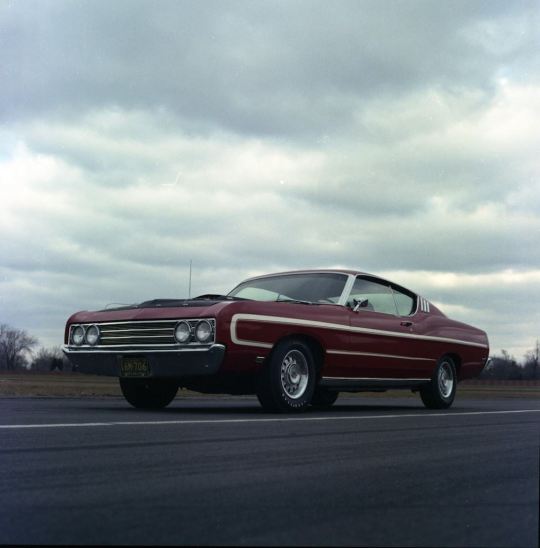
7. 1969 Ford Torino Talladega
Source: Ford Half a century on, the Plymouth Roadrunner Superbird and Dodge Daytona get all the love when it comes to NASCAR homologation specials. But in 1969, Ford tried its hand at aerodynamics too and built the Torino Talladega. Starting with a Torino Sportsroof, Ford worked with the Holman-Moody race shop to design a sleeker, longer front clip and rear fascia for the car. The Talladega was honed in the wind tunnel — a relative novelty for the era — and powered by the 429-cubic-inch V8 found in the Boss Mustang. Production was over by March; Ford only built 754 of them and they were barely advertised, but the slippery cars dominated during the ’69 season, winning 29 races. In 1970, however, the 200-mile-per-hour Superbird ruled NASCAR, and the Talladega’s time in the spotlight was over. Today, the Talladega (and near-identical Mercury Cyclone Spoiler II) are bargains on the collector market compared to the beak-nosed Mopars.
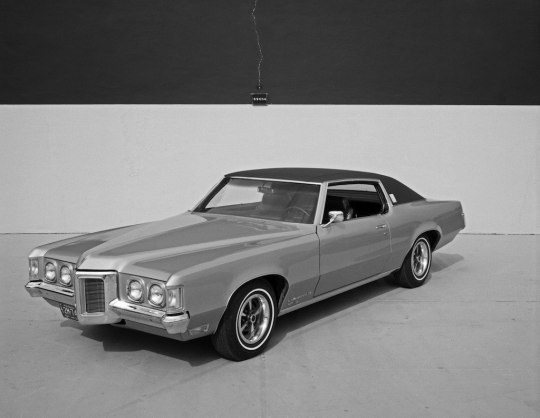
8. 1969 Pontiac Grand Prix SJ
Source: General Motors The second-generation Grand Prix is largely remembered for its role in popularizing the Personal Luxury Coupe segment, but in its early days, it was one of the hottest cars on the street. With a long hood (the longest hood of any production car in ’69, in fact) and short deck, the Grand Prix was available with Pontiac’s 390-horsepower 428-cubic-inch V8, allowing it to scramble from zero to 60 in 6.5 seconds and run the quarter mile in 15 seconds at 97 miles per hour. Its combination of luxury and power made it the Grand Prix massive hit for Pontiac; within a few years, any semblance of performance would be gone.
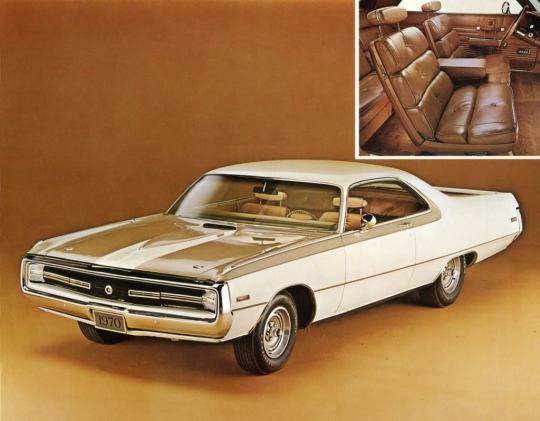
9. 1970 Chrysler Hurst 300
Source: Fiat Chrysler Automobiles As early as 1970, Chrysler die-hards were feeling nostalgic for the 300-letter series, which ended in 1965. The 300-series carried on, but performance had taken a back seat as mid-sized muscle cars had picked up the go-fast mantle. Chrysler tried to recapture the magic for ’70 by outfitting a 300 coupe with the interior from an Imperial, a fiberglass hood and decklid, a 375-horsepower 440-cubic-inch V8, and a Torque-Flite automatic to handle all that power. At 18.5 feet long and 4,400 pounds, the big Chrysler could still make zero to 60 in 7.1 seconds and run the quarter mile in 15.3 seconds. With just 500 built, the Hurst 300s rank as one of the rarest Mopar muscle cars of all time.
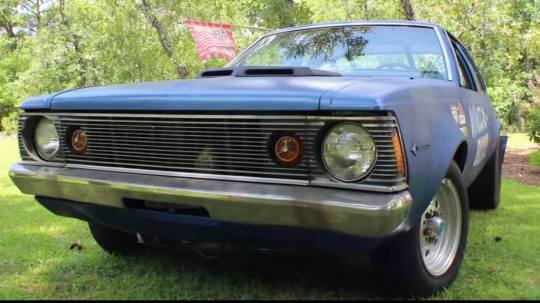
10. 1971 AMC SC/360 Hornet
Source: Chris Andrews Productions via YouTube In the ’60s, AMC’s red, white, and blue Rebel Machine and SC/Rambler muscle cars failed to move the sales needle for America’s last independent automaker, but they sure caused a scene wherever they went. For 1970, the company had introduced the compact Hornet and Gremlin to replace the Rambler, and with them came the SC/360 Hornet. With an available 285-horsepower 360-cubic-inch V8 under the hood, the small Hornet could hit 60 from a standstill in 6.7 seconds, and run the quarter mile in 14.9 seconds at 97 miles per hour. But in 1970, displacement still ruled the day, and despite being cheaper than a Plymouth Duster 340, AMC found just 784 buyers for its smallest muscle car. We think it’s aged remarkably well, and would love to take one of these ’70s-era sleepers to the drag strip.
#car#cars#muscle car#mopar#american muscle#dodge#ford#chevrolet#chevy#amc#american motors#pontiac#pontiac grand prix#chrysler#hurst#olds#oldsmobile#studebaker#automobile#auto#coupe#Mercury
193 notes
·
View notes
Text

Amazing historic photo Ford Motor Company at its River Rouge Plant Dearborn, Michigan taken in 1965
Rarely do we come across a photo that has this much goodness going on it at once, but here we are. For starters, the picture was taken in front of the historic Ford River Rouge Complex, which was the largest integrated factory in the world when it was completed in 1928. More than 100,000 workers were employed there, even during the Great Depression in the 1930s.
Over the years, The Rouge churned out all sorts of automobile models, tractors, boats, aircraft components, tires, and various other products. The Model A was produced there, as well as the Ford Thunderbird, Mercury Capri, and four decades of Ford Mustang models. Today, The Rouge site is home to The Blue Oval’s Rouge Center, which includes the Ford Dearborn Truck Plant, where the Ford F-150 is built.
This picture is full of Ford models, including a Galaxie and Falcon, a handful of Lincolns, and a whole slew of Mustangs. But everything else in the photo is a Blue Oval product as well – including the car haulers, which we bet a lot of folks would love to get their hands on today. Even the train has “Ford” printed on the side, because of course it does.
And of course, there are some snazzy looking businessmen standing by the trucks, doing what we can only imagine is, well, business. At least that’s what it looks like. Regardless, it’s nice to take a trip back to this very different, very cool era, if only for a few precious minutes
6 notes
·
View notes
Text
While I’m posting about awesome Aussie cars, let’s talk about the Ford Falcon. We had it in America during the first few years of production, but it was replaced by the Mustang in 1965 (64.5 technically… car companies are weird sometimes). They kept making it in Australia until 2018, though, and the many generations of Aussie-only Falcons are some of the coolest and most underrated muscle cars of the past half-century. If you’ve ever watched the original Mad Max and wondered what is that cool weird hot rod Max Rockatansky is driving, well, that’s an Aussie Falcon. Here are some Falcons I like! Whee!






6 notes
·
View notes
Text
Yes! This! An important point.
It's been mentioned here (many times) that other EVs brick themselves and yes indeed, virtually all of them have had teething pains.
But here's the thing: other automakers honor their warranties.
For many reasons.
Firstly, because (unlike Tesla) other automakers use the franchise model of sales, wherein dealers purchase the right to sell a company's vehicles in an exclusively protected region. You won't see, for example, two Ford dealerships next door to each other. This is because regions are jealously guarded and franchisees will sue the living shit out of their franchisers for breach of contract.
Yes. I know. It is extremely weird thinking of automobile dealerships as the good guys. But in this case? It works.
Because, unlike Tesla, where every Tesla dealership is owned by Tesla, and run 100% by Tesla employees, those evil bastards will fight tooth & nail to protect their franchise. It's a profit motive.
So when your Chevy self-immolates or bricks itself or the paint falls off under warranty YOU CAN REST FUCKING ASSURED that the dealer you bought it from will fix it as fast as humanly possible because:
it doesn't cost them a dime (Chevy reimburses)
they actually profit off warranty repairs (Chevy pays their labor)
they have the chance to upsell you on other stuff
they want to cement themselves as Your Best Friend Forever™ so you will give them repeat business
Another reason is that US car makers learned some valuable lessons (had their asses kicked) during the 1960s/70s at a time when workmanship was in the toilet.
GM, for example, was famous for their 1970s cars rusting through their paint on the dealership lots.
Ford made some supremely dangerous vehicles in the 1960s and got called out on it (re: Ford Falcon).
Chevy's Corvair was the topic of Ralph Nader's book Unsafe At Any Speed, an explosive 1965 exposé of grift in the auto industry. Nader's book & subsequent congressional hearings were instrumental in making cars safer. We have Nader to thank for airbags, crumple zones, and 5-mph bumpers.
Then in 1975 the Magnuson-Moss Warranty Act got passed (otherwise known as the Lemon Law) that demanded product warranties MUST be honored, with horrific penalties if they weren't.
All of these factors combined to make US car companies liable for their fuckups, and to at least try and address customer grievances sincerely. It was a come-to-Jesus moment that has lasted ever since.
And because all auto makers work on that same level playing field, and birddog each other neurotically for violations, and have robust mechanisms in place to honor warranties... we've had relative peace in the automotive sector.
Yeah, sure, occasionally somebody gets burned. But usually the [evil, capitalist] system kicks in to correct the issue.
But not Tesla.
Tesla has been discovered to be actively hiding their transgressions. Making shit. Blaming the customer. Lying about warranty coverages.
And powerful people have finally noticed.
All of this, obviously, is from a very US-centric perspective. I cannot wait to see how the EU tunes Tesla up for their many transgressions.
Yee fucking haw.
A Tesla driver has brought his wife's Model 3 in for servicing because the power steering ceased operating after the car went over a normal speed bump. The service manager (note that Tesla, unlike other car manufacturers, owns and operates all of its dealerships, so the workers there are Tesla employees) identifies the culprit: A system component has become corroded—probably, he says, because the car went through a car wash. The repairs will cost $4,400. The driver observes, reasonably, that he has never heard of a car's wiring being damaged by simply taking it through a car wash.
Reuters did a huge receipts-padded article on the grifting operation that is Tesla, that they have been knowingly selling shoddy, defective, dangerous cars. Then, when those shitty cars break within the first few hundred miles, Tesla blames the owner for "abuse" and won't honor the warranty.
18K notes
·
View notes
Text
IPs That Could Benefit From LEGO Speed Champions

Speed Champions sets have been known to be both detailed and relaxing builds by the community.
Besides making F1 vehicles and expensive cars from Lamborghini, AMG, BMW and so on, LEGO has also ventured out into making licensed IP Speed Champions cars: two from The Fast & The Furious films and the Aston Martin DB5 from the 007 films.
What if I said there's opportunities for other cars that had the potential to become Speed Champions sets if LEGO were to fork out for the licensing but that potential is sitting on the table with nothing being done? You'd be as surprised as I am.
Some of the following IPs are of my own opinion that could benefit from being turned into a Speed Champions set.
Dumb & Dumber
Known as one of the best and funniest films of 1994, Dumb & Dumber is known for the infamous Mutt Cutts van that Harry drives until he is laid off and him and best friend Lloyd go on a road trip to Aspen to return a briefcase full of money.
A concept for the van itself could be somewhere in the 300 piece range with some stickers representing the Mutt Cutts logo on both sides of the van and a license plate sticker as well as some interesting building techniques for the outer design of what is essentially a dog. The minifigures of Harry & Lloyd could be them on the road trip or even one of Harry in his dog suit with a dog in the back, a red and yellow container set that represents the ketchup & mustard and other nods to the film. The van is based off of the 1984 Ford Econoline.
Rain Man
Known as one of the best films of the 80's and one of the best representations of ASD, Tom Cruise & Dustin Hoffman knocked it out of the park with Rain Man. Cruise's character Charlie acquires his father's car after his father's death but also discovers he has an autistic brother named Raymond and they take a cross country road trip discovering and bonding with one another and becoming real brothers.
The car in question is the 1949 Buick Roadmaster that could follow the new formula of Speed Champions being 8 studs wide with a mixture of both stickers and prints with interesting building techniques and pieces to build the inside (especially the red seating) and can include a removable top that on the car itself went up or down. As far as minifigures, Charlie & Raymond are given and an optional third could be Charlie's girlfriend since in one scene, they're all in the car at once so they could find a way to design & build a car to fit 3 minifigures instead of only 2.
Mad Max
Possibly one of the most iconic cars of any action film, Mad Max's Interceptor/Pursuit Special is based off the 1973 Ford Falcon XB GT Coupe and became Max's iconic ride starring Mel Gibson.
Alongside the Max minifigure (which could include a wrench and maybe a creative piece that could look like a double-barreled shotgun), this could work using the 8-stud wide concept LEGO uses for Speed Champions with the built engine on top of the car along with rust-like stickers seen in the ECTO-1 set to show its' look through the wasteland and either stickers for the headlights or printed pieces and a sticker for a potential license plate on the back of the car.
The Hangover
This trilogy of films took off and became one of the best comedic films of the late 2000s directed by Todd Phillips who has been known for comedic style films.
The car in question that the movie has is the 1965 Mercedes 220SE and can work based off the new SC formula and can work either as a top up or top down vehicle depending on builder liking. You'd have your set of stickers representing the doors and the inside dash along with brick colored seating that matches the film. The minifigures would be the core four characters of Doug, Stu, Phil and Alan and if LEGO wanted to, throw in Mike Tyson's tiger or even stickers that represent when the tiger destroys the inside of the car and even some references to the film that each of the 4 characters can hold in one of their hands.
The Dukes Of Hazzard
This is gonna be a controversial choice for one major reason: The Confederate flag. If you're unaware of what the General Lee is, it's probably the most famous fictional car in all of pop culture (or at least ranks as one of the top ones).
Based off of the 1969 Dodge Charger, the General Lee could be a standard for the 8-stud wide model of Speed Champions cars seen in current LEGO sets as long as they get around the issue of showing off the Confederate Flag but still make it authentic to the show so fans and builders know it's the General Lee. The obvious minifigures would be Bo & Luke Duke with the "01" on the sides of the car being stickers and a generic flag sticker atop the car.
These are only my thoughts on some IPs that could be turned into Speed Champions sets if LEGO can acquire the licensing to but I'm aware people will have differing opinions so let's discuss them.
Have an awesome day and build the brick on...
1 note
·
View note
Text



1965 Ford Falcon Wagon
1 note
·
View note
Text
Car Spot: 1965 Plymouth Barracuda
It was the first pony car. The Plymouth Barracuda is this week's spot.
The first barrage in the pony car wars Ford and Plymouth were in a race to be the first to enter the pony car era and to get there they were using off-the-shelf stuff. Ford, the Falcon, and Plymouth the tried and true Valiant, Chrysler’s A-body, and while it shared a great majority of parts and bodywork the huge and distinctive wraparound rear glass made it stand out. It was the largest ever…

View On WordPress
#1965 Plymouth Barracuda#Barracuda#Car Spots#car spotting#car spotting 70&039;s era muscle cars#Plymouth Baracuda#pony cars
0 notes
Text




Ford Falcon Hardtop 1965. - source Classic and Modern Show Cars AU.
93 notes
·
View notes
Text





Ford Falcon
1965 Falcon sedan delivery, 289, C4
58 notes
·
View notes
